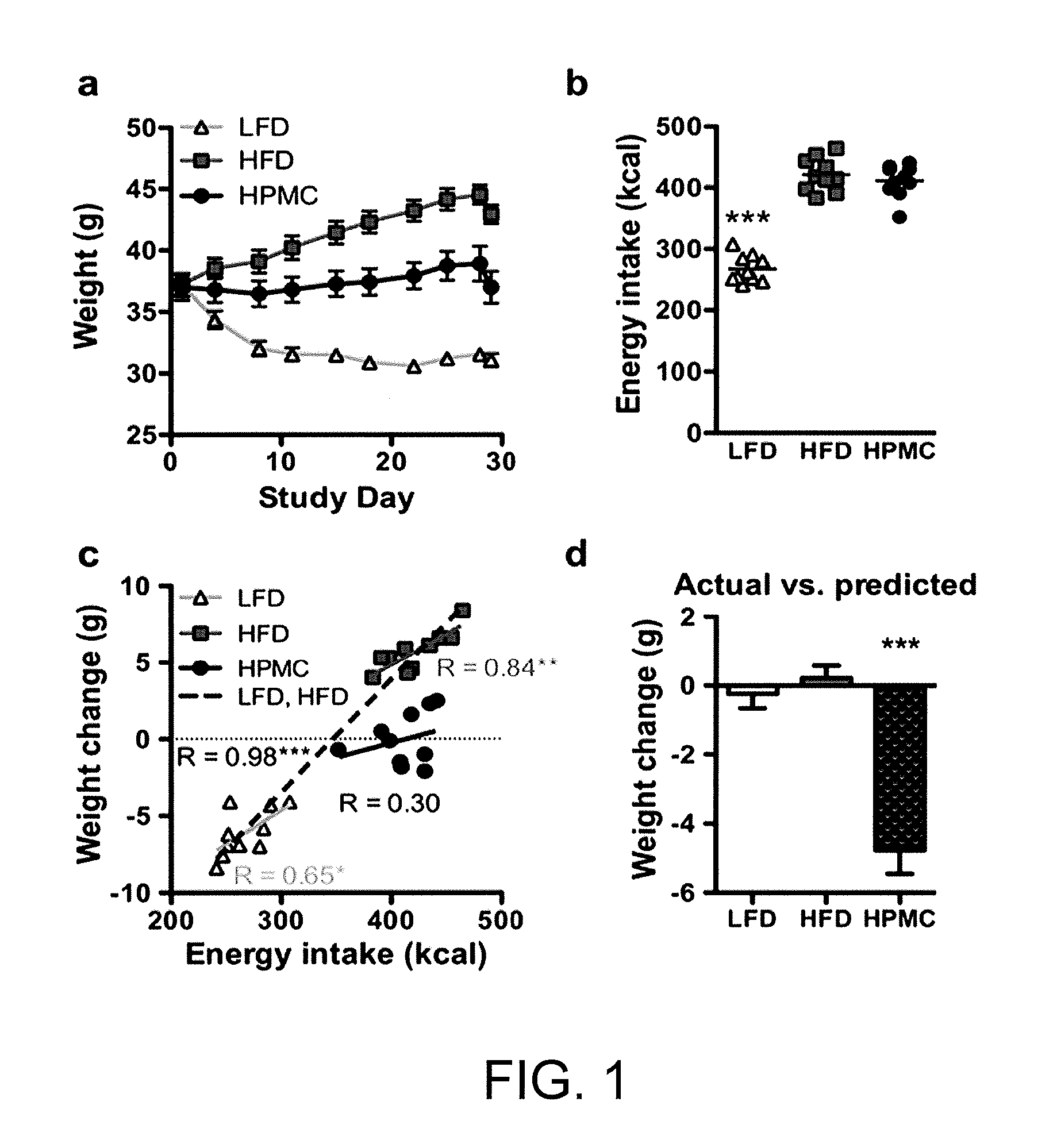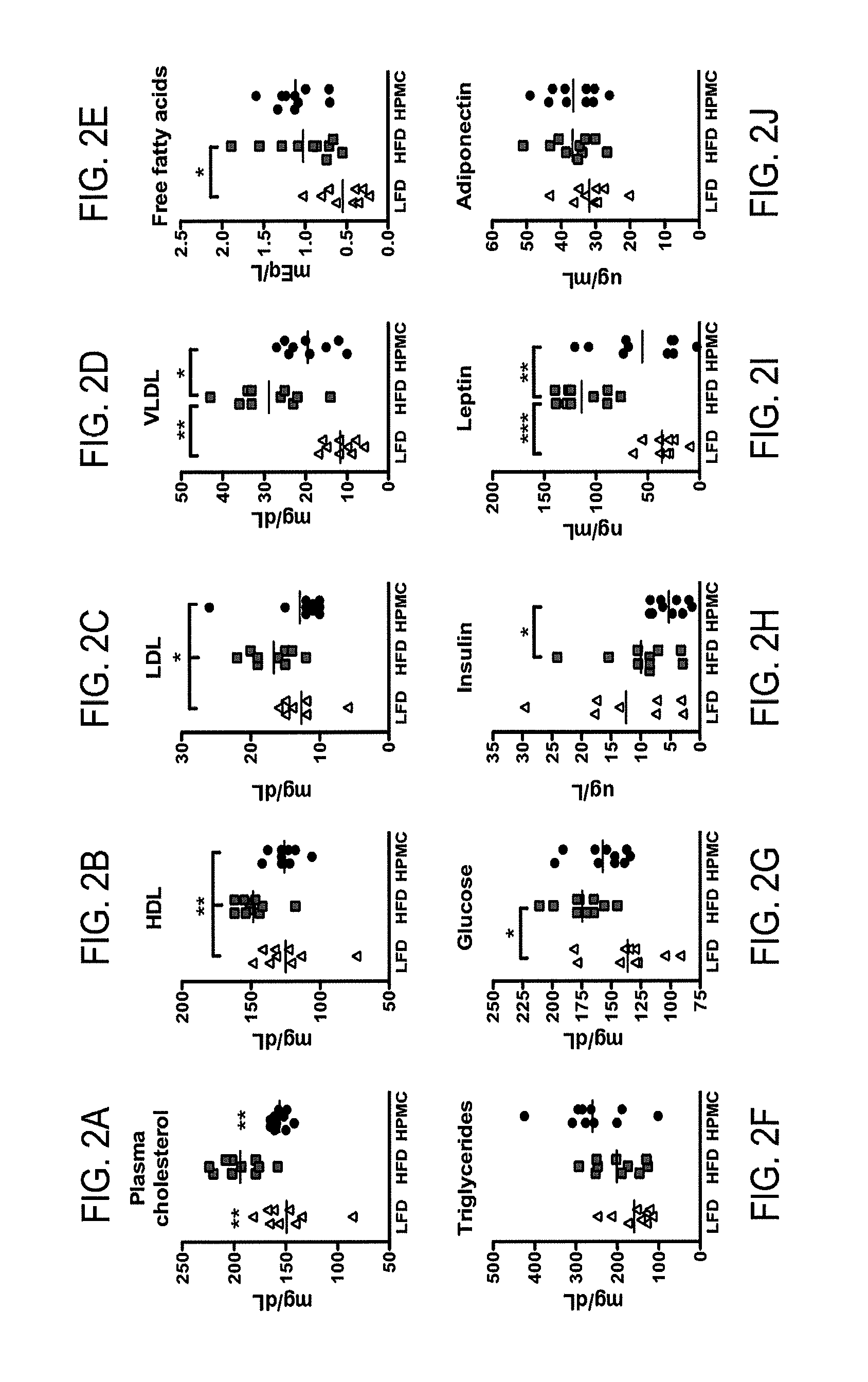Compositions and methods for treating obesity and related disorders by characterizing and restoring mammalian bacterial microbiota
a technology of bacterial microbiota and obesity, applied in the field of compositions and methods for treating obesity and related disorders by characterizing and restoring mammalian bacterial microbiota, can solve the problems of insufficient explanation of the rise in obesity, the role of bacterial microbiota in these conditions has not been clearly understood or appreciated, and the microbiota is highly extensive. , to achieve the effect of promoting weight loss in a mammal, reducing the population of firm
- Summary
- Abstract
- Description
- Claims
- Application Information
AI Technical Summary
Benefits of technology
Problems solved by technology
Method used
Image
Examples
example 1
Analysis of Diet-Associated Changes in Intestinal Microbiota of Mice
Materials and Methods
1. Animals and Diets
[0195]Thirty (30) obese male C57 / B16J mice (from Jackson Laboratories, Bar Harbor, Me.) were studied. All mice were fed a high fat (60% fat) diet (also termed diet-induced obesity [DIO] diet; supplied by Research Diets Inc., New Brunswick, N.J.) and water ad libitum for at least two months. Then baseline fecal samples were obtained and animals were divided in three groups of ten (10) mice each. One group was maintained on the high-fat (60% fat) diet, one group was converted to a low fat (10% fat) diet (also supplied by Research Diets Inc., New Brunswick, N.J.), and the third group was fed a 60% fat diet+HPMC. Hydroxypropyl methylcellulose (HPMC) was present at 8 percent weight level in the treatment diet. It was mixed with the powdered components of the diet. The HPMC had a methoxyl content of 19-24 percent, a hydroxypropoxyl content of 7-12 percent and a viscosity of about 2...
example 2
A Cholesterol-Lowering Dietary Fiber Perturbs the Murine Intestinal Microbiota
Materials and Methods
[0240]Animals and Diets were the same as in Example 1, supra.
[0241]Hepatic lipid analysis. Lyophilized liver samples were extracted using an accelerated solvent extractor (Dionex ASE, Sunnyvale, Calif.) at 100° C., ˜13.8 MPa with 75 / 25 hexane / 2-propanol, dried and weighed to determine the percentage of total hepatic lipids, and hepatic total cholesterol, free cholesterol, and triglyceride levels (Roche Diagnostic / Hitachi 914 clinical analyzer).
[0242]Fecal lipid analysis. Fecal lipids were extracted on a Dionex ASE system using a mixture of hexane and 2-propanol (3:2, v / v, 2% acetic acid) at 15 MPa and 60° C. for 30 min, then divided into two aliquots. The first sample was analyzed for saturated and unsaturated fatty acid composition by GC separation. Briefly, the fatty acids in the lipid extract were methylated using boron trifluoride methano127, and the derivatized samples analyzed by...
example 3
Testing of Probiotic Compositions of the Invention in Mouse Models
Methods and Abbreviations
[0271]Abbreviations. All abbreviations also apply to FIGS. 22-24. CSHEPCc=at least one of Coprobacillus, Sporacetigenium, Holdemania. JO=at least one of Johnsonella, Oscillibacter. Prebiotic=at least one of trehalose, cellobose, maltose, mannose, sucrose, lactose, salicin, mellibiose, raffinose, galactose, and fructose. C57B6 mice=C57 / B16J mice (approximately 2 months old in the beginning of the experiment).
3.1 Determination of the Effect of CSHEPCc and / or Prebiotic Treatment on Weight Gain in a DIO Mouse Model
[0272]As schematically shown in FIG. 22, four groups of C57 / B16J mice (at least 10 mice in each group) are fed 60% fat (DIO) diet from two months to four months of age. At four months of age, group 1 is kept untreated (control), group 2 gets CSHEPCc delivered by gastric gavage (Coprobacillus, Holdemania, and Peptostreptococcacea Incertae Sedis are delivered as live cells, Sporacetigenium...
PUM
| Property | Measurement | Unit |
|---|---|---|
| viscosity | aaaaa | aaaaa |
| viscosity | aaaaa | aaaaa |
| particle size | aaaaa | aaaaa |
Abstract
Description
Claims
Application Information
 Login to View More
Login to View More - R&D
- Intellectual Property
- Life Sciences
- Materials
- Tech Scout
- Unparalleled Data Quality
- Higher Quality Content
- 60% Fewer Hallucinations
Browse by: Latest US Patents, China's latest patents, Technical Efficacy Thesaurus, Application Domain, Technology Topic, Popular Technical Reports.
© 2025 PatSnap. All rights reserved.Legal|Privacy policy|Modern Slavery Act Transparency Statement|Sitemap|About US| Contact US: help@patsnap.com



